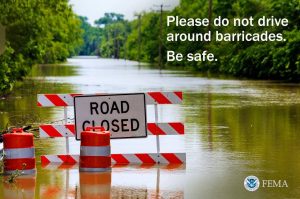 Flooding is the leading cause of severe weather-related deaths in the U.S. claiming on average nearly 100 lives a year. Most of these deaths occur in motor vehicles when people attempt to drive through flooded roadways. Many other lives are lost when people walk into or near flood waters. This happens because people underestimate the force and power of water, especially when it’s moving. The good news is it is preventable with the right knowledge and tools.
Flooding is the leading cause of severe weather-related deaths in the U.S. claiming on average nearly 100 lives a year. Most of these deaths occur in motor vehicles when people attempt to drive through flooded roadways. Many other lives are lost when people walk into or near flood waters. This happens because people underestimate the force and power of water, especially when it’s moving. The good news is it is preventable with the right knowledge and tools.
A mere six inches of fast-moving flood water can knock over an adult. And it only takes 12 to 18 inches of flowing water to carry away most vehicles including large SUVs. If you come to an area that is covered with water, you will likely not know the depth of the water or the condition of the ground under the water. This is especially true at night, when your vision is more limited. Play it smart, play it safe. Whether driving or walking, any time you come to a flooded road, follow this simple advice: Turn Around Don’t Drown.
Here are a few more tips to keep you safe during flooding:
- Always plan ahead and know the risks before flooding happens. Monitor NOAA’s All-Hazards Radio, or your favorite news source for vital weather related information before, during and even after a disaster.
- If flooding is expected or is occurring, get to higher ground FAST! Leave typical flood areas such as ditches, ravines, dips or low spots, and canyons.
- Avoid areas already flooded, especially if the water is flowing fast. Do not attempt to cross flowing streams. Turn Around Don’t Drown.
- NEVER drive through flooded roadways. Road beds may be washed out under flood waters. Turn Around Don’t Drown.
- Do not camp or park your vehicle along streams and washes, particularly during threatening conditions.
- Be especially cautious at night when it is harder to recognize flood dangers.
- Never cross any barriers that are put in place by local emergency officials. Not only is this dangerous, but many states and communities levy steep fines for people that ignore barricades or other road closure indications.
- Play it safe, Turn Around Don’t Drown.
Visit noaa.gov for more Turn Around Don’t Drown resources and visit www.weather.gov for the latest weather forecast information.